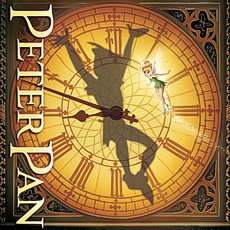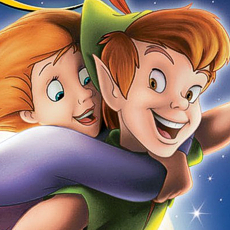Walt Disney Productions (February 5 1953), Walt Disney Home Entertainment (March 6 2007), 2 discs, 77 mins plus supplements, 1.33:1 original full frame ratio, Dolby Digital 5.1 and Original Mono, Rated G, Retail: $29.99
Storyboard:
Facing her last night in the nursery for telling too-juvenile stories of pirates and adventurers to her younger brothers and exciting them too much, Wendy Darling awakes to find the hero of her tales, the mythical Peter Pan, is very much alive and real and flying about in their home looking for his escaped shadow. With the help of his pixie Tinker Bell, Peter finds the shadow but not before a chase around the nursery wakes up Wendy’s brothers John and Michael as well. Wendy helps Pan re-attach his shadow and in return Peter offers a trip to his home world of Never-Land, second star to the right and straight on ’till morning, where children never grow old.
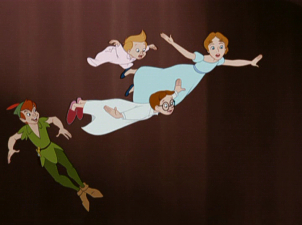
Excited at the prospect of meeting pirates and Indians for real, the Darlings launch themselves – with faith and trust and a little bit of pixie-dust – out of the window and off to Never-Land, where the wicked pantomime-esque villain Captain Hook, crazed from the last time he fought Pan and lost his hand to a crocodile, awaits the return of his opponent for another showdown. While Peter leaves John and Michael with his band of Lost Boys, Tinker Bell has taken a dislike to Wendy and arranges with Hook to have them all captured, setting the scene for a series of skirmishes that lead to the ultimate encounter between young and old, good and bad…
The Sweatbox Review:
When I was five, and VHS piracy was but a glint in the eye of the guy with the first linked up tape-to-tape configuration, tapes of older movies were passed around the movie industry without much thought. I was thrilled when my Dad brought home a slew of Disney pictures, Snow White, Dumbo, Lady And The Tramp, One Hundred And One Dalmatians, The AristoCats and Peter Pan among them, along with Superman: The Movie, and its these early viewings that I put down to my life-long appreciation of the work from the Disney Studios, as well as Superman remaining my favorite film of all time.
As one is able to do when they are a child, I made no distinction between Disney and Warner Brothers at that age and lumped Superman and Pan together in an unofficial double bill: both films concerned heroes that fly, of course, and Superman even makes reference to the earlier story about the Boy Who Wouldn’t Grow Up. At my ripe old adult age now I can appreciate that Superman too is essentially a fable for the big kid in all of us, but at that time I thought of Peter Pan as “Superman for kids” and as such it also quickly became one of my favorite films, and is unquestionably still my top pick from Walt Disney’s “middle period” of the late 1940s and the 1950s.
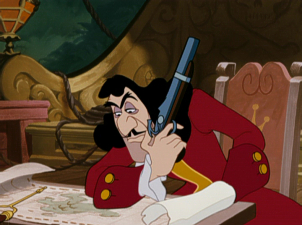
First released in 1953, Peter Pan marked a return to form for Walt, who had bounced back triumphantly after the war with 1949/50’s Cinderella but then stumbled again with what critics of the time felt was a mishmash version of Alice In Wonderland (1951) which is now seen as something of an avant-garde masterpiece. Both Alice and Pan were based on English literary sources, and as such Walt was keen to remain faithful, dragging out production of the films to, in Pan’s case, which was intended to follow Snow White as the second feature, over ten years. It’s exactly this attention to detail, and putting the brakes on a project until it was ready to come to fruition, that Walt excelled at and indeed made each picture stronger, leading to an almost perfect representation of Peter Pan onscreen.
The plot is perfectly suited to Walt Disney, himself a boy who never grew up, and who created his own worlds of imagination. It’s also the most out and out magical – an overused word – of all of Disney’s films, being set almost completely in another time and place. Likewise the characters take on their own hyper-real world personas. Each comes to the screen in simple, economical storytelling fashion. Wendy is growing older but wants to retain her youthful innocence, Tink is the jealous type, John is an adventurer, totally off in a land of his own though perhaps wanting to be taken seriously, Michael is the youngest, happy to go with the flow, and the rest of the Never-Landers, including the Lost Boys, are a mixed bunch comprising all humanity, but mostly a feeling of loneliness and not belonging anywhere stable. A problem for some may be the racial stereotypes that would never be gotten away with now. Indeed the Native American Indians, played here as somewhat comical savages, were markedly absent from the surprisingly poignant 2002 rehash Return To Never-Land. But then, is this a comment on the time or not? The Pirates, each one more stupid than the last, get the same treatment, so it’s more a case of adults being silly, surely as per Barrie’s intentions.
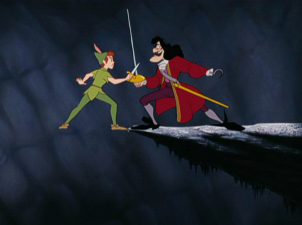
Peter himself is something of an enigma, and while many have praised the film’s comical villain Hook, let us not forget this is a guy with a very real and valid reason for revenge, which itself places some doubt on Peter’s state of mind as well, and who dupes innocent kids into a trap, is willing to throw them overboard to a waiting croc, and who attempts to kill our hero outright with an actual bomb! Any complaint that the back-stories that led to these feelings remain un-elaborated upon and that the characters could be described as somewhat un-rounded misses the point…Pan was developed as a pantomime-styled stage play – and an interactive one at that – and the film retains this feel. Also, being a film instead of a play did lend Walt and his artists some extra leeway: unlike Alice’s Tenniel illustrations, there was no set appearance for how the characters should look, so more freedom could be taken with the visual development. There are also changes to the interaction in that where we were once asked to clap furiously and show our belief in fairies in order to revive Tinker Bell – something that wouldn’t have worked in a screen version – we are instead involved in a dramatic moment of suspense.
At the same time, this isn’t a great story – Barrie’s fault, not Walt’s – for role model females. Wendy is in awe of Peter, Tink is jealous of Wendy, the Mermaids are out for themselves and even Tiger Lily seems to be pretty loose when it comes to settling down. In fact, the only “woman” to come out of Pan very well is Pan himself, since he was usually portrayed by a female actress on stage. Walt’s film marks the first time the character was represented as male, voiced by Disney child star Bobby Driscoll of Song Of The South fame. That’s not to say that Pan is strictly a boy’s own picture, since girls can get a big kick out of enjoying the character’s soap-styled green-eyed conflicts playing out, and the romantic fantasy of the “will they or won’t they” kind keeps the chemistry bubbling under between Peter and Wendy, and the film does boast one headstrong female role.
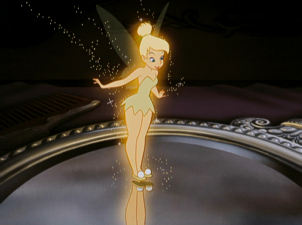
For Peter Pan is also notable for being the first time Tinker Bell developed into a real woman with human attributes instead of being just a sprite depicted on stage as a simple ball of light that floated around the set. The often-told misconception is that Tinker Bell was modelled on sex-bomb du jour Marilyn Monroe, and given the blonde connection and unmistakable body shape it’s an interesting bit of trivia to ponder over. This has been disputed over the years, perhaps in case the owners of Monroe’s likeness sued the Studio, and the official line is that Tink’s live-action model Margaret Kerry (a brunette we must remember) inspired Marc Davis and the animators. Even though Walt himself added fuel to the Monroe flames by admitting such in a magazine article, it’s since been said that it couldn’t possibly have been Marilyn’s physique that was incorporated into Tink’s design because she wasn’t a big enough name to have had any influence. But this is incorrect to assume Monroe wasn’t a “face” in Hollywood at the time, having already starred with the Marx Brothers in Love Happy as far back as 1949, enjoying poster-billed bit parts in such notable films as John Huston’s The Asphalt Jungle and All About Eve in 1950, and headlining a slew of Fox comedies in 1951-52. By the time Peter Pan was in release, she was a huge box-office draw, with the iconic Niagara, Gentlemen Prefer Blondes and How To Marry A Millionaire appearing in 1953 alone. If Kerry gave Tink her movement and legs, I still like to think that the animators added a bit of blonde Marilyn in there too, whatever the certified explanation is.
Although Tinker Bell is perhaps the most well rounded character in the film, she never talks, leaving the vocals of the film down to a line-up of well-known Disney voices of the time. Driscoll, of course, creates the world’s first male Pan, and brings a fresh take on the character, sounding young and carefree, and ready to take on anything. He’d come to prominence as Walt’s first contract star, having been discovered for Song Of The South and appearing in subsequent films So Dear To My Heart and Walt’s first live-action picture Treasure Island. His Pan stays true to the original intent: full of bravado when needed, but a spoilt little boy when he doesn’t get his own way, and kudos to the screenwriters for not subtracting this trait and making Peter a bland hero figure. Sadly, Pan was to be Driscoll’s last film for the Studio and despite early Academy Award recognition and good notices for his excellent performances in other films, most notably RKO’s The Window, he became one of the many young names that got dragged down into Hollywood’s seedy spots, and died a few short years later.

Also returning, after providing the lead for Alice In Wonderland, is Kathryn Beaumont, essentially playing the same English lass part, while she is joined by her Alice co-star Bill Thompson as Smee, being given much more to do with a great character this time around. Long-time animation vocalist June Foray pops up as a mermaid and an Indian squaw, and even Tink’s live-action model Margaret Kerry gets a line as another mermaid. The voice cast is among the best of Disney’s features, with not a weak performance in the entire picture. Best of all is Hans Conried, suitably snarling and menacing as Hook, and sympathetic as the post-Never-Land Mr Darling. Conried would become an animation favorite and went on to lend his voice to numerous Disney films, most memorably becoming the face of the Magic Mirror in many later TV appearances.
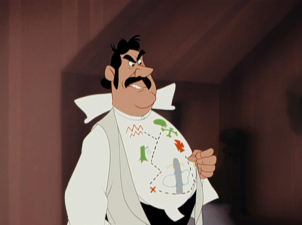
Staying with the sound, and the score, by long-serving composer and underrated musical genius Oliver Wallace, and songs are among some of Disney’s best, written by Sammy Fain, Sammy Cahn and Frank Churchill among others. Is there anyone for which The Second Star To The Right doesn’t conjure up the sentiment of When You Wish Upon A Star but without the cloying corniness, while You Can Fly! excels at creating a song that lifts one up even when not accompanied by the film’s soaring over London images? Following The Leader has entered popular culture to the extent of Whistle While You Work from Snow White and is unquestionably the film’s one true out and out comedy moment, a place to have fun before the tension racks up for the following face off between Pan and Hook. The poignancy of Your Mother And Mine, is expertly handled, wherein Wendy realises that she’s growing up and it’s a natural thing to be happening, like it or not. All of which are transparently interwoven cleverly throughout by Wallace’s orchestral music, lush and restrained when needed, but also full of big brassy moments including the signature three-note fanfare for our hero. Unbelievably, neither the songs nor score were even nominated for Oscars, though Disney did pick up four awards that year for other releases.
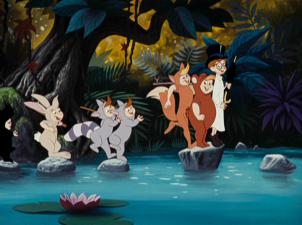
As good as the soundtrack is, an animated film is all about the images it provides and in Peter Pan’s case we’re treated to some spectacular animation – another reason it’s remained my favorite. Lines are clean as they would be in later fare such as Lady And The Tramp and Sleeping Beauty but retain a looser feel that allows for the broad strokes of the story to play out. As with the equally opulent Pinocchio, each line has been individually colored, and if any film (perhaps apart from Pinocchio) in the Walt-era library looks like it could have been made last year on the Studio’s computer assisted CAPS system, this is it. The three-dimensional shot looking down as Hook climbs up the ropes, sword in hand, toward Pan is simply stunning, water glistening in the background, and dark lighting instantly suggesting the shift in the film’s tone, and Hook’s relentless desperation.
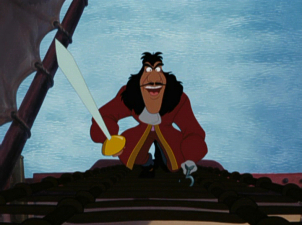
Added to this is the sheer perfection of the largely human cast, always a struggle to animate convincingly, but by now the artists were at the top of their game. What’s most effective is the feeling of weightlessness they are able to infuse into their essentially weightless drawings. How does an animated character fly without seeming as if they are merely floating? Directed by Clyde Geronimi, Wilfred Jackson and Hamilton Luske, Peter Pan answers this dilemma expertly, continually moving the characters throughout the air and even giving them a way of thrusting themselves forward that really looks as if they are powering themselves along. When they shoot off over London and the clouds part beneath them to reveal the city, one could almost fall into the shot, such is the depth to the artwork.
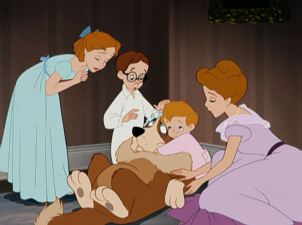
The rest of the more earth-bound humans are good too, not least Mr Darling, who carries his own weight with the grace of a true theatrical performance. These dynamics really help in the exciting moments too, and Pan is one of Walt-era Disney’s most action-packed films, with plenty of swash for your buck. Even in the pause for breath of Your Mother And Mine, the plot continues to move forward, as Hook, Smee and their crew get ready for their ambush of the Lost Boys. The touches never stop: as well as Tink we’re presented with first-time views of the “real” Darlings’ St Bernard nanny-dog Nana and the infamous Crocodile, only ever seen as actors and props on the stage. “You’d never miss them but they’re here” moments also include Hook’s swapping of his silver hook for a gold plated one in order to charm Tink, revealing the many other devices he’s able to screw on to his hand, and Tinker Bell’s ubiquitous pixie-dust, which simply visualises “magic” incarnate…just great touches that add so much to already immensely enjoyable entertainment.
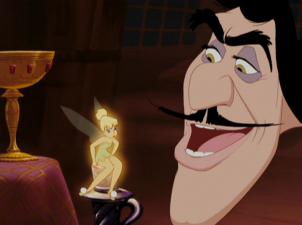
After a short-story book debut, James Matthew Barrie brought Peter Pan to the stage in 1904, which was later adapted with the earlier material into the well-known book. The film Finding Neverland is a good account of the creation of the story, based on Barrie’s own encounters with those who had captured the innocence of childhood but finding them having to balance that against growing demands of adulthood. Walt’s film, although it’s the only major work not to use any of Barrie’s actual stage dialogue, does retain some of the deliciously dark undercurrents from the original, though they will go unnoticed by the younger set. Walt was perhaps mindful that Alice had taken so many liberties with Lewis Carroll’s source novels, and had been particularly criticised in its native Britain…a feat he didn’t want to repeat. As such, Pan is as faithful in spirit an adaptation as they come, right down to Conried maintaining the stage tradition of playing the dual roles of Hook and the Darling children’s father. As the latter, he brings a warmth to his role that suitably ties up the film’s last line, whereupon it is clear that Pan’s message isn’t so much about children needing to grow up, but for the adult not to lose sight of the child within them…classic Disney sentiment shared with Barrie’s sensibilities.

Peter Pan was the last feature length movie all of the Nine Old Men would work on in the capacity of directing animators, after which one could say that the films became more fragmented, especially without Walt’s personal touch. By this time he had become interested in live-action picture making, the thought of expanding into television was already strong in his mind, and of course his own Never-Land, the theme park that would bear his name, was very much a big project for him. Another change at the Studio would be the way their films were distributed: a spat with RKO over their refusal to support the first feature-length True Life Adventures documentary led to Walt setting up his own distribution company, Buena Vista, and much later success and Oscar-wins for those nature films. Pan was to be the last animated feature to carry the RKO title card, adding another layer of irony in that it was released in the year that Walt himself stopped being the young hot-shot wunderkind of Hollywood and became one of the big boy players himself.
Although Pan wound up being a massive commercial and critical hit, Walt himself was apparently disappointed with the end result, especially mindful that he felt an audience could never care for Pan as a character. He’s an adolescent in all manner of ways…having fun but not caring about the consequences; selfishly unaware of his actions and that bringing the kids to Never-Land is itself a dangerous proposition. It’s true that he is arrogant too, but he just comes over with such an extremely charming manner…something that would definitely appeal to any child, boy or girl. And that’s also why Pan works…it is a thrilling adventure that plays to both sexes and all ages, un-tinged by Walt’s sometimes over sentimentalism until the very end, creating a perfect closing moment. Perhaps that is why Peter Pan has lasted, and will continue to remain the most mischievous – and youngest – of all the Disney pictures.
Is This Thing Loaded?
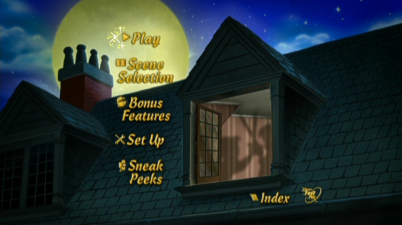
When the bonus specs for this latest Platinum title were released, I was not a happy bunny. For my favorite Walt-era film did not look like it was stacking up well in anything that was compelling or even new. Many features seemed lifted from previous 45th Anniversary LaserDisc, Limited Edition DVD or Special Gold-styled DVD versions, with only the mysterious Walt Disney Christmas Show from 1951 holding any intrigue. I became very excited when it dawned on me that this show was a precursor to the DisneyLand television program, the second (and final) such special after One Hour In Wonderland before Walt began his weekly show proper in 1955.
But…alas, as early reviews started to come in there was no mention of the special – and the one thing, I’ll admit up front, that I was really only interested in from a valuable extras point of view. That I now confirm that the Christmas Show is very much missing from this set is extremely disappointing indeed, and as such the remainder of the truly unique bonus features on offer sink this “Platinum” edition to the bottom of the pile, perhaps even lower than the fluff-filled Cinderella and near-miss Lady And The Tramp from this time last year. Fasten your seatbelts and get ready for a bumpy ride…it’s not gonna be pretty, but let’s see how damaging the line-up really is…
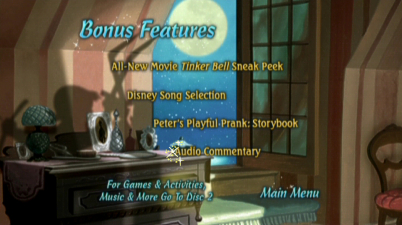
The extras kick off on disc one with the FastPlay system selecting the usual Sneak Peeks, here promoting the next Platinum title, The Jungle Book (which looks very nice in its cleaned up state), a new extended trailer for Meet The Robinsons, a new release for Peter Pan: Return To Never-Land, and a teaser that shows absolutely nothing at all for the troubled Tinker Bell movie. From their own menu, additional previews play for The AristoCats: 2-disc Special Edition, which isn’t scraping the bottom of the barrel at all (and looks to follow the recent Robin Hood by presenting a cropped widescreen image), The Little Mermaid III (ditto!), Ratatouille, Mickey’s Great Clubhouse Hunt, Disney on Blu-Ray, and the Movie Rewards and Vacation Club promos.
Moving into Peter’s world, the 16×9 menus are pretty basic affairs, with only the movie soundtrack providing anything remotely interesting. An Index option lists all the features on both discs, while heading into Bonus Features on disc one presents options for a surprisingly slim line up of bonus content of varied worthiness. First up, and probably most disposable even though I am actually intrigued and somewhat looking forward to this project when it debuts in fall 2008, is a Tinker Bell preview. Presented in letterboxed widescreen, this is a totally new, two-and-a-half minute look at the first movie in this new Fairies series, though how much is still on show in the completed movie now that it has returned to development for fine tuning is open to question.

Looking like a magical, miniature version of the Spice Girls, we meet Tink and her fair fairy friends, all of them with a speciality in magic. The look is suitably storybook-ish, and actually very traditional in appearance but unfortunately the animation, as it looked in the first teaser release last year, is of the decidedly Barbie/Polar Express zombiefied mannequin look. Hopefully, now that it’s gone back to the drawing board, we’ll get something that’s more in tune with Disney’s high animation levels. Swirling camera moves can only cover up so much, and Tink doesn’t look her old self, being more a 60s popstrel than anything else, which doesn’t bode particularly well.
Disney’s Song Selection is nothing more than the usual alternate Scene Selection option that offers up the movie’s song sequences in an abrupt fashion complete, if needed, with on-screen lyrics, and Peter’s Playful Prank read-along continues the chaff, being a straight lift from the previous Special Edition release. It’s nicely put together, using music, dialog and scenes from the movie, but is nothing new.
Following suit is the feature-length Audio Commentary, hosted by Roy Disney. Now, the Platinums have cribbed from earlier releases for some of their content of course, especially the luxurious LaserDisc box sets of old, but usually they bring something new to the line-up too. For those with the Pan Special Edition, you’ll find nothing new here as this is the exact same track. The good news is that it’s amazingly packed, but Roy’s dry voice betrays the fact he’s reading most if not all of the information from notes. Luckily, his voice is punctuated throughout by other pre-recorded comments from notables such as Leonard Maltin, Marc Davis, Kathryn Beaumont, Frank Thomas and Ollie Johnston, Ward Kimball, John Canemaker and archive recordings of Walt himself, among others. Although fragmented by design, the remarks have been mostly edited well to the goings on happening on screen, though not always scene specific, and there’s never a silent moment. While I would not have expected a newly minted track, it is worth mentioning that there’s nothing new here for those with the previous edition. And that, seriously, is it for disc one.

On to the second platter, where we might expect to find a lengthy documentary, or detailed analysis of the production’s development, but unfortunately, there’s no such luck. To say there’s nothing new or, more pointedly, substantial here wouldn’t be fair, but after an absurdly crude and basic menu intro, I dropped into Backstage Disney first to see what we had. The requisite documentary, You Can Fly: The Making Of Peter Pan is certainly here, but again it’s an archive piece, this time actually dating from as far back as the 1990s LaserDisc release! And that this has been ported over, with its 16 – yes, just 16 – minute running time intact is, if you’ll excuse me, just a bit of a joke. Though this is a quickly paced and essentially valuable piece, nothing new has been added or been expanded upon, and the interview segments, especially a much younger (and thinner!) looking Leonard Maltin, who used to host these programs at this time, belie the age of the material. For first timers (and after three or four releases how many can’t have already seen this?), the storyboard section and deleted pirate song will enchant, but there’s certainly the space for something more substantial, and the glimpses at The Walt Disney Christmas Show from 1951 that’s been dropped from this release are especially frustrating!

Why I Made Peter Pan is a great new inclusion, but short at less than eight minutes. Intro’d for some reason by current Disney directors Ron Clements and John Musker, the pair explain how an article written by Walt himself was recently discovered in the archives. It’s very nearly the best thing on the disc, reconstructing the story using a terrific sound-alike for Walt’s voice as the Story Meetings on the Bambi set so expertly reproduced. Walt explains how he came across the story as a young boy, how he played Peter in a school play and the eventual process of turning JM Barrie’s adventure into one of his animated pictures.

Visually, reconstructions of Walt’s early days have been created in non-authentic video, and accompanied by the usual Studio archive footage and tremendous amounts of production art. Coupled with the commentary, there’s obviously more than enough material to recreate that Story Meeting format as seen on the Bambi disc but that this lasts less than eight minutes and is acknowledged to be an abridged version again shows the lack of the Studio to go the whole nine yards in creating a definitive release.
Better is The Peter Pan That Almost Was, which does go into the development of the movie far deeper than any other supplement. I was lucky enough recently to visit Paris, France, and the amazing collection of Disney artwork they had on show as part of the Grand Palais’ retrospective of Disney animation and its many European art sources. Since Pan is, of course, a British story, the film’s art was prominently on show, with the legendary Mary Blair’s concepts gaining due attention. Also in the exhibition, and more of a find for aficionados, was a collection of David Hall’s concept art for a much earlier 1930s version of Peter Pan that never made it to the screen. Here those works are highlighted among others, again by current Studio directors Musker and Clements, in the disc’s finest new piece.
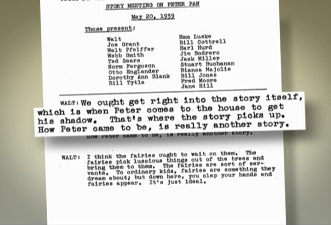
Running a generous and healthy 21 minutes, we’re taken back to the development of the movie, covering two alternative openings (given overdue attention on the packaging), deleted concepts (including Nana’s journeying to Never-Land along with the Darlings, and John’s staying in London), and even one sequence that ended up in Steven Spielberg’s later Pan sequel Hook. Excellent and informative beyond anything else in the set, even if it doesn’t touch on the proposed live-action bookends that had Wendy, John and Michael reading the book that comes to life in animation, from an early presentation.
David Hall’s artwork is again showcased in one of several Art Galleries. With over 460 images between them, the nine sections present Visual Development pieces, David Hall Concept Art, Mary Blair Concept Art, Character Design, Storyboard Art, Layouts And Backgrounds, Production Photos, Live-Action Reference and Publicity. Of particular interest are the Development, Hall, Layouts And Backgrounds and Publicity stills – all of them gorgeously rendered with intricate detail, though the lack of any up-to-date poster art is a slight disappointment as I love the modern touches the artists bring to these updated versions. Nevertheless, someone putting this DVD together had their head screwed on when it came to these galleries, and this is a top-notch selection. Unfortunately, there are none of the usual audio-bites that sometimes accompany selected works, and the publicity art we are presented with is as close as we get to how the film was marketed over the years – there are no preview trailers included, a rarity for a Platinum edition, and yet another disappointment.

Making up for the lack of vintage, time of production footage, depending on your point of view, is The Peter Pan Story, a black and white 1952 publicity featurette, running 12 minutes, that was created by Walt to run on TV to promote Pan. A dryer than usual Disney piece, Walt is less the showman and more the salesman in his producing role, starting the piece with a re-cap of great homespun storytelling through the ages (even including excerpts of Song Of The South, purists!) and creating hype around the apparently demanding task of bringing JM Barrie’s Pan to the animated screen.

Why the depending on your point of view? Well, this would again be a great and fascinating addition to the DVD if had not been seen in years, but again this featurette made its home video debut over ten years ago on that darn anniversary LaserDisc and popped up again on the previous DVD. That this is the promotional item that contains the most footage to be sampled in the other supplements also dims its wow factor somewhat, and the final four minutes of clips is as blatant a tease as they come.
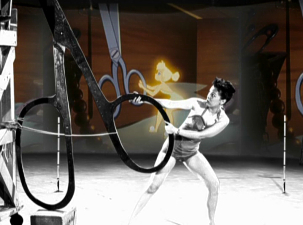
Finally in Backstage Disney is the light ‘n’ fluffy Tinker Bell: A Fairy’s Tale, an 8:25 running featurette that looks at the impact the character has since her creation as a ball of light in Barrie’s original play and first screen appearance in Paramount’s 1924 silent feature, to her role in Walt’s take and the live-action reference participation of Margaret Kerry and further career as a figurehead for the company, second only to Mickey Mouse. Despite its validity as a commentary on this important face in Disney’s lexicon, I couldn’t help but keep up my cynical approach to this set and wonder if this unusual focus on a secondary character wasn’t actually another, more stealth-like promotion for the upcoming Fairies movie – a suspicion duly confirmed by the blatant inclusion of a nod to that project near the end of this clip. And since when was Tink a fairy anyway? She’s always been a pixie until now…

With the collectors’ features supposedly out of the way, I’m pleased to say that Music And More actually offers up a couple of extra tidbits by way of a Deleted Song: The Pirate Song, which duplicates the 2:20 acetate recording and storyboards from the You Can Fly documentary in a stand-alone form, and Never-Land: The Lost Song, a delightful piece that has later Disney composer Richard Sherman musically completing an unfinished lyric for a song from the abandoned 1940 version of the film. I always love spending time in the company of Sherman, and the two-minute introduction really shows his love for all things Disney.
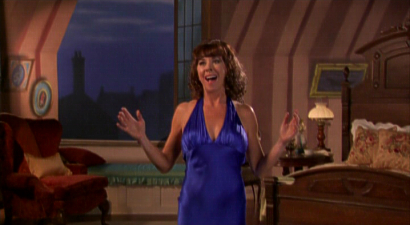
Better still, Belle’s singing voice Paige O’Hara has been drafted in to record the song for this release and the full 3:15 video, set in the Darlings’ nursery and also selectable from its own menu option, is something quite special. Much less so is the Disney teens’ version of The Second Star To The Right, performed by T Squad from the DisneyMania 5 album. Unlike previous Disney pop tunes, this one bears little resemblance to the original melody at all and is three minutes of pure promotional filler.
Into Games & Activities and the biggest joke of all: a full-length read-along version of Peter Pan. Running the entire 77 minute film in a pre-restored version, this ABSOLUTELY, TOTALLY REDUNDANT version merely adds read-along style text graphics to the print…the BIGGEST WASTE OF SPACE I’ve ever come across on any DVD and much worse an offence than the pan-and-scan crop-job included in last year’s Lady And The Tramp. If the inclusion of this is what necessitated the dropping of the Walt Disney Christmas Show, I am royally flushed! A TRAVESTY, nothing more, nothing less. Ugh!
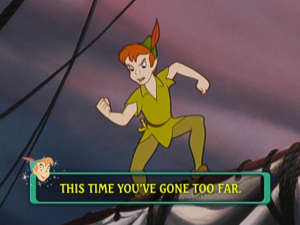
With that abomination fresh in my mind, I was not in the mood to “enjoy” the set-top game Camp Never-Land: Train To Be A Lost Boy, a collection of three pastimes that has extremely poor character voices trying their best to sound excitable. Smee’s Sudoku Challenge (confusingly sans any Smee-input) might be fun for us older kids but the rules will drive younger ones crazy, while Tarrrget Practice is a slow point-and-shoot endeavour that soon becomes boring. Lastly, Tink’s Fantasy Flight is the kind of “fly-thru” in which pressing left or right on your remote has little effect on the trip in question, prompting the question again of who plays these things anyway? Near the Pirate ship, you’re asked to input a secret password, but I didn’t make it through all the games and couldn’t be bothered to find out what the treasure was. Knowing my luck, it’s that darn Walt Disney Christmas Show, but somehow I doubt it.
Finally – yep, that’s it – is Peter Pan’s Virtual Flight, another two minutes of wasted disc space given over to a pointless Pan’s eye view flight through a drab-looking 1900s London and an overly colored, bland Never-Land, all recreated with cheap looking computer graphics. For some reason, there are two ways to watch, as a Pan-guided trip or as a loop that plays continually without the poor sound-alike’s ramblings. I’m really not sure I get the point of either.
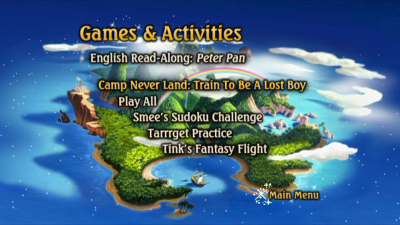
So, what’s missing? While the commentary is nice, it’s a re-hash from the recent SE, and the lack of a decent “making of” featurette really is a poke in the eye, the one that we do have again lifted from previous editions, as is The Peter Pan Story. The lack of any theatrical trailers is appalling in that this should be a definitive version, while the LaserDisc pressing also contained audio-only extras such as storyboard presentations for two alternate scenes, plus additional art and live-action reference galleries. Since this material was available, why the no-show here, and considering Peter Pan’s evergreen status, why none of the ’specially produced features that usually grace a Platinum edition, such as anything on long-serving Studio cast members Beaumont, Driscoll and Conried, a note on the DisneyLand ride, the restoration or even a plug for the company’s Barrie biopic, Finding Neverland?
In other territories, Pan’s regular special edition contained the complete 1924 Paramount silent feature, wonderfully restored, but only glimpsed at here. Likewise, there’s nothing on Never Smile At A Crocodile, the oddly deleted lyrics for music still in the film that later became a breakout hit song (“don’t be taken in/by his welcome grin/he’s imagining how well you’d fit within his skin”). As Pan was a late entry into the Platinum pantheon, I would suggest that this is less a celebration of one of Walt’s most successful films, and very little more an attempt to regurgitate archive material of various vintages and essentially promote the upcoming Tinker Bell movie, which ironically has been pushed back a year due to its blatant toy commercial appeal.
Yes, one can make the argument that these are “older” films and do not have the supplements available to pack out these double discs, but it doesn’t wash. Disney was spectacular at archiving all the production processes of the animated films, and there is certainly the material there to bolster such editions, especially in Pan’s case several theatrical trailers and the one hour Christmas Show. Those additions would have absolutely warmed up this otherwise dinner of cold leftovers, but I fear that we are once again being taken for a ride in the bid to entice collectors over to the Blu side of high-definition video discs. Fine for those who can afford such luxuries, but not so much fun for those who love these movies and deserve the best features, particularly when they have been announced and are available.
So…my marks for the bonus content here is purely for the newer material…recycling such a large amount of stuff at this Platinum level and omitting several important additions doesn’t warrant an impressive nod at all. Color me very disappointed, though you probably guessed that already!
Case Study:
The usual keepcase with second disc tray is housed in some nice sleeve art that promotes Tinker Bell larger than the three human kids. I wonder why? A shiny embossed slipcase replicates the artwork on the outside, with a fold-out DVD Guide inside along with a Disney Movie Rewards booklet featuring the usual barrage of “must-have” promotional items and savings.
Ink And Paint:
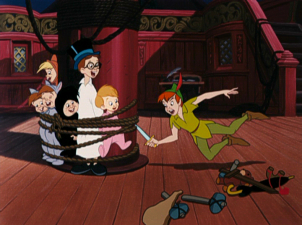
Not having the Limited Issue and skipping the Special Edition due to a lack of content added to the LaserDisc that I was very happy with, this is my first time for Peter Pan on DVD. With the news that DTS Lowry Images were cleaning this up, I was expecting so much more than we get here…a soft transfer with over saturated warm colors and crushed blacks. Like Bambi, I may find myself going back to the more muted, but less direct-to-video coloring of my old LD. What have they done to my favorite picture? Made it look like the recent sequel Return To Never-Land, that’s what…
As is current Disney practice, the blue castle logo has been inserted, but appropriately the film also retains its original RKO distribution card. We’re given a fantastically rock-stable image, but despite the clarity there’s something eerie about seeing these older Disney cartoons looking as sterile and lifeless as this does in the titles. Sometimes a little grain or gate weave can add so much more magic to the image than the most clinical of restorations. Some brief credits for the restoration team have been added as is general Platinum custom, in the style of the original main titles, accompanied by some choice story sketches.
Scratch Tracks:
Announcing its 5.1 Enhanced Home Theater Mix on the cover with pride, I have to say the sound makes up somewhat for the picture, being a fairly involving mix, sounding better than the Surround 4.0 track on the LD and less tinny in the high-end. I’m assuming it’s a brand new mix over the 5.1 included on the Special Edition since this is specifically labelled as an Enhanced track, which plays as the default. It’s not too over the top as some of these things can be, obviously down to the limitations in separating the masters. Thankfully, the also-included original mono track is no slouch either, having been cleaned up and sounding just as good if not as spacious. French and Spanish 5.1 dubs, from the previous releases, have been added.
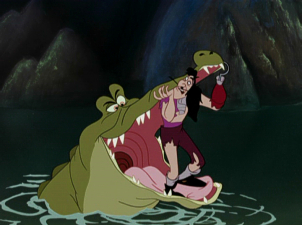
Final Cut:
My favorite Walt Disney animated adventure has undergone a transformation, and not for the good in my opinion. The image is passable and will go unnoticed by most, but it’s over colored and lacking detail. And don’t get me started on those extras! Perhaps by the time Peter Pan goes Blu-Ray, the extra definition will counteract the softness on show here, while all that extra space could easily hold the important supplements originally promised us. The inclusion of the exact same film again with karaoke-style words onscreen is an insult. To say that I was disappointed with this Pan is nearly an understatement, but if it were not for the undeniable pull of the film, this could be a total misfire.
As a collector I would have probably picked this up to complete my Platinum collection, but am sure glad I was able to receive a review copy instead this time around. It has to be said that the Platinums seem to have taken their drastic drop in quality since the introduction of two per year. With the Treasures and Legacy collections ongoing, and more regular updated editions of other classics in the Disney library, my feeling is that the spread-thin folks at Buena Vista Home Entertainment responsible for creating and/or okaying content for these sets can’t keep up! The recent additions (Cinderella, Lady And The Tramp, The Little Mermaid, Peter Pan) don’t hold a candle to those previously released (Snow White, Beauty And The Beast, The Lion King, Aladdin) and calling them “prestigious” surely went out the window long ago. Certainly not an improvement on the Special Edition in terms of picture quality; the handful of additional extras may tempt some, but this Peter Pan is no essential upgrade. In fact, as Hook might say…“Poor show”.
 | ||
 |







